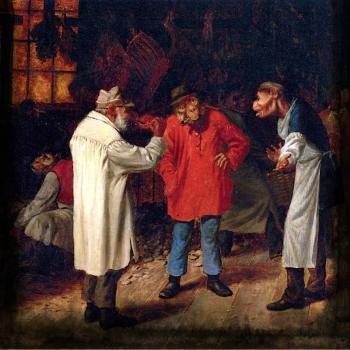The Secret Mission is the title of my weekly Substack Newsletter. This is the 2nd issue. If you like the newsletter, feel free to sign up to receive it by email. I publish it every Monday at 7:00 pm ET. It is free!
Contents
- Random Bites
- Calvin’s Ghost (#8): Ripped Balloon (Fiction)
- The Divinity of Data (Essay)
- Is “Anti-Racism” by Definition Self-Defeating? The Case of Princeton University (Note)
- Alt-Right Obsessions: Lord of the Rings (Note)
- Inklings
Random Bites
- President Kanye – Kanye West will not be our next president. This the confident declaration from someone who in 2016 also wrote Donald Trump will not be our next president. But assume for the moment that lightning will not strike twice. In itself, Kanye’s candidacy is probably not terribly significant. But it matters enormously in advancing further the burgeoning opportunities for social media-driven celebrity candidacies. Others less emotionally shredded than Kanye will follow. Mark Cuban, for example—whose recent remarks on “national anthem policing” extend a pattern of well-timed, calculated statements designed to leverage his sports business profile and boost his profile in larger national conversations. I’d bet real money that Cuban will run for president in 2024.
- Torture Lawyer – Advocates for the idea of a Gulliver-like “unitary executive” unconstrained by the impedimentary threads of a hapless legislature are drinking deeply from the recent Supreme Court decision that upheld the Obama-era DACA program, arguing that presidents can simply use “prosecutorial discretion” to choose not to enforce federal laws. Alongside Attorney General Willima Barr, Bush-era “torture lawyer” John Woo has most prominently advocated for this extreme view of presidential power, is currently advising President Trump on ways he can immediately seek to “legislate” from the Oval Office. We need no further evidence to confirm Alexander Hamilton’s dismal view of the prospects for propping up the Constitution, “this frail and worthless fabric.”
- QAnon – NPR interviewed Travis View, co-host of the QAnon Anonymous podcast, about the recent prolieration of QAnon-affiliated congressional candidates and the conspiracy’s movement penetration into the sluiceways of Republican Party politics. QAnon is a descendant of the Pizzagate conspiracy, an incredibly elaborate conspiracy theory hatched and spread on the 4chan, 8chan, and 8kun message boards that claims a satanic cabal of pedophiles control all the levers of power in media, entertainment, and politics. QAnon spawn additionally believe that Donald Trump is well aware of this cabal and working to battle it with the help of a group of military intelligence officials known as Q Team. The rising influence of QAnon in the Republican Party should scare the shit out of the party estalishment.
- Storm Troopers – Trump Adminstration Department of Homeland Security officials—all of whom are serving in a non-confirmed “acting” capacity—are aggressively defending their use of unidentified federal law enforcement officers to defend federal property in Portland, Oregon and other cities protesting sysemic police and law enforcement brutality targeting African Americans (and Native Americans). In an obviously coordinated and chilling set of interviews, virulent climate-denying and anti-gay, anti-immigration ideologue Ken Cuccinelli—along with DHS officials Chad Wolf and Mark Morgan, Trump chief of staff Mark Meadows, and attorney general William Barr—came close to openly declaring war on “violent anarchists” and “criminals” plotting attacks on government facilities.
Fiction
Calvin’s Ghost (#8): Ripped Ballon
Matters did not improve after the disastrous first day of school the previous September, the hoped-for friendships not materializing, Lawrence drawing further into himself, school an unmitigated, agonizing struggle, Lawrence unable to crawl from bed in the morning, bedroom stank-suffused, piles of dirty clothes, torn black-light posters hanging loose from the walls, a broken-framed fishing photo of Lawrence, Eli, and Tobias askew and half-smothered on his desk, shades drawn, appearance deteriorating, stress deepening his acne, slumping his shoulders, accentuating his flinch. Lawrence an immiserated, angry, terrified insect. Lawrence gyrating south, deflating like a ripped balloon.
Tobias, battling his own demons, could not handle the descent, his anger at Lawrence barely veiled, easily uncorked, never far from conflagration, triggered by back-talk from Lawrence, smirks from Lawrence, sly and sarcastic and disrespectful asides from Lawrence, Tobias unable to catalog and absorb the pain of it all, and so both Tobias and Lawrence, discharging surplus despair and anger upon each other, sliding into close encounters of the furious kind, with Tobias lambasting, savagely reproaching, imposing his punishing will, the slow rise from his chair in the sitting room, tightly gripping his glass, carrying his strength and anger with him, propelling fist to face, knee to stomach, Lawrence crumbling, screaming, cursing, sobbing, and always now, several times a minute, flinching, eyes blinking furiously, Lawrence a Sudanese Monkey, hands drifting toward his face, always his face, warding off blows, real and imaginary, past, present, and future.
[Read More]Essay
The Divinity of Data: Artificial Intelligence, the Death of God and the End of Individuality
In the first decade of the 21st century, an unsexy, inoffensive software markup language called XML solved a problem that has been the predicate for all major historical transformations: extracting content from its conventional forms and repurposing this content in ways never before imagined. XML became the vehicle for liberating data – as digital representations of the stuff of the material world – from established publishing formats. With almost no one paying attention, new possibilities for endlessly reproducing, recombining, and remapping data emerged early in the second decade of the 21st century. This “Big Data” revolution heralded and enabled the profound advances in artificial intelligence and machine learning of which we are only now becoming fully aware.
The advent of Big Data, artificial intelligence, and machine learning have rapidly encroached upon (inhabited, invaded, colonized, body-snatched, pick your verb) the biological and social foundations of individual human identity – the language, reason, judgment, and desire of the embodied, conscious self. Data collection and extraction has in short order hollowed out and inverted – metaphysically if not literally – the physical forms and landscapes through which we have always, as a species, mapped our reality. Within several more decades, it now seems clear that digital data and artificial intelligence will reconstitute and reformat what it means to be human.
[Read More]Notes
Is “Anti-Racism” by Definition Self-Defeating? The Case of Princeton University
Since July 4, hundreds of faculty at Princeton University have signed a remarkable letter to the school’s president and administration. The letter—which at nearly 4,000 words more closely resembles a tome—demands “in the name of racial justice” that the university “amplify its commitment to Black people and all people of color on this campus as central to its mission, and to become, for the first time in its history, an anti-racist institution.”
We are experiencing an unprecedented moment of political and environmental chaos on college campuses and in the nation, generally. With Princeton, alongside most other colleges, preparing to open for what is sure to be a turbulent and angry fall term, this letter invites scrutiny of the significance, promise, and pitfalls of its message across (at a minimum) the following dimensions.
- Demands. In language that ranges from strident to uxorious (this is more of a slack-jawed observation than a criticism or judgment), the letter systematically presents 48 demands to the Princeton University community, including 16 university-level reforms, 11 faculty-level reforms; 5 postdoc-level reforms; 4 graduate-level reforms; and 12 undergraduate-level reforms. Under the anti-racism umbrella, these demands cover a broad range of issues and challenges—from the institutional to the procedural to the financial to the symbolic to the behavioral—including minority representation in campus positions of power, influence, and status; to departmental hiring practices and commitments; to student financial and emotional support; to the dismantling of monuments and symbols of racist oppression; to multifarious behavioral microagressions.
- Template. The overarching promise of this letter is that its proposed reforms might serve as a useful template for institutional anti-racism reform at other colleges and universities (and perhaps other significant nonprofit and private sector organizations). Certainly, the Princeton University administration might be advised that the best approach to working with the letter’s signators would be to shape its outcomes for that purpose. One might imagine possibilities for uniting around reforms that can scale across both time and space that would mitigate some of the more obvious risks of self-conflagration if the focus remains entirely on internal reforms.
- Ouroboros. The reality of “institutional racism” remain largely assumed in the Princeton faculty letter, a set of incontrovertible assertions and articles of faith. The letter’s implicit tone is hat anyone questioning these assertions is at best naive and at worst a hostile party. But if the goals of the anti-racism reform movement are to rebuild the university and its mission on non-racist foundations, successful achievement of these goals absolutely requires fleshing out these assumptions with research and data points about institutional racism that can instantly neutralize and disarm those who—not illegitimately—resent being required to accept at face value every assertion underpinning the letter. Without this data foundation and coherent narrative anchored to this data, any movement founded largely on a negative proposition such as “anti-racism” risks the self-defeating prospect of becoming merely a self-consuming, tail-eating ourobouros Another way to frame this risk is that successful “anti-racism” reforms must include specific, positive, enduring visions of change and hope that can emerge from this list of anti-racist demands and serve as benchmarks for progress to which institutional parties critical to achieving successful reform—including the Princeton University trustees and alumni—can commit and aggressively pursue.
- Imagination. A quite-excellent July 17 blog post from NYU Stern School and education influencer, Scott Galloway, spotlights the looming financial moment of reckoning for the tenure-driven, corporatist model of higher education that has prevailed in the United States since the end of World War 2 and the inception of the GI Bill. Addressing this crisis will require enormous imagination and flexibility. We may well remember this period as the marker for the death knell of faculty tenure, which has long been anachronistic—and a source of terrible inequality on college campuses. Tenured faculty will not let go of the tenure sinecure without a ferocious battle—indeed, they may be willing to destroy higher education to preserve this privilege. But this set of converging crises is also relevant to the Princeton faculty letter, which is itself proposing anti-racism reforms based on resourcing and revenue models that are collapsing before our eyes.
Palantir and Anduril: Peter Thiel’s LOTR Fever Dream
Several weeks ago, I read a story in the Washington Post with the headline “Silicon Valley tech start-up Anduril raises $200 million to create a software-driven Defense Dept. contractor.” Anduril is a three-year old technology startup funded by Peter Thiel and Marc Andreesen and founded by Brian Schimpf (previously director of engineering for Thiel at Big Data analytics and surveillance company, Palantir) and Palmer Luckey (founder of the virtual-reality company Oculus, which launched as a Kickstarter in 2012 and which Facebook purchased two years later for more than $2 billion).
Anduril designed the portable surveillance tower for the Department of Homeland Security’s southern border “virtual wall.” While the company’s revenues are still fairly minimal, its current valuation of more than $2 billion hints at the optimism surrounding its future prospects (particularly one in which current market values leading NASDAQ to all-time highs during a disease pandemic and economic depression reflect bullishness about technologies that can serve as humanity’s new overlords).
Palantir and Anduril are, of course, both iconic names from J.R.R. Tolkien’s Lord of the Rings trilogy. “Palantir” is the name for the “seeing stones” deployed by the Dark Lord Sauron and his fallen wizard henchman Saruman. One of the most fateful moments in The Lord of the Rings occurs when the hobbit Pippin—always charmingly impulsive and curious—cannot resist gazing into the seeing stone Gandalf has located and secured, inadvertently making his identity known to Sauron. Anduril is the elven-forged sword that Aragorn, the human heir to the throne of Middle Earth, reforges as he begins his quest to help Frodo carry the “one ring” into Mordor where the only hope lies for the “free peoples” of Middle Earth (humans, elves, and dwarves) to destroy the ring and save their world from everlasting night.
I grew up reading Lord of the Rings on nearly an annual basis and my sons inherited my love for the books (and subsequently the movies). While romantic ardor for LOTR always signaled a kind of desexualized purity for its (mostly male) readers, the books haven’t escaped the generalized precarity of our age. Tolkien himself has of course been “complexified” beyond the cardboard unidimensionality of his donnish profile (burnished for decades by his son Christopher). His own horrific experiences in the trenches of World War I are now widely known to have inspired much of the tragic detail and subtext of Lord of the Rings.
But critics have also taken Tolkien to task for burying his story within crusty layers of medieval mythologizing that imply an essentializing of “Western” values and virtues that those holding newly critical, postmodern lenses to history and literature cannot abide. At the same time, more recent British (Philip Pullman) and American (George R.R. Martin) dragon slayers have both upstaged Tolkien with epic tales that far more directly build worlds recognizable to us today, with storylines and dramatic tension emerging from battles between avatars of scientific and religious authority (Pullman) and from kingdoms built upon the intersectionality of sex and power (Martin).
But if Tolkien’s Middle Earth now appears vaguely foppish and inaccessible to new generations of readers, the allure of his stories appears to be as strong as ever amongst a coterie very smart right-wing intellectuals and technology mavens, particularly (although not exclusively) those from coming of age in the latter portion of the 20th century. I am here specifically thinking of Steve Bannon (who has more than once referred to Hillary Clinton’s “basket of deplorables” as his “hobbits”) and Peter Thiel, who almost certainly is responsible for naming his two most significant (and most darkly sinister) companies Palantir and Anduril. At the same time, medieval mythologies, tropes, and values have insinuated themselves amongst white male alt-right cohorts, many of whom have fixated upon Christian medieval conquerors such as Charles (the Hammer) Martel, the 8th century Frankish Duke and Prince who unified France and fought back the Saracens in the mythically significant Battle of Tours in 732.
The literary, emotional, and political threads connecting Lord of the Rings to both the alt-right and to influential intellectual and technologist heroes of the movement such as Bannon and Thiel deserve further scrutiny. For Bannon and Thiel—who are both in their own ways “radical traditionalists”—technology specifically seems to serve as the bridge between their radicalism and their traditionalism. To fully understand the symbolic and emotional anchors of “Trumpism,” we need to make more explicit the significance of this “nostalgic radicalism”, and if we are moving into a “post-Trump” era, what meanings and influence it may sustain going forward.
Inklings
- Elections – Warren Joked About Her Dog Voting Democrat. GOP Officials Insist Electoral Pet Fraud Is No Laughing Matter.
- Law – Hack Of 251 Law Enforcement Websites Exposes Personal Data Of 700,000 Cops
- Neuroscience– Poker and the Psychology of Uncertainty
- Plants – Why Some Buddhist Monks Ordain Trees
- Rural – Rural Virginia Teen Holds Second Black Lives Matter March After Cross Burnt In His Front Yard


















